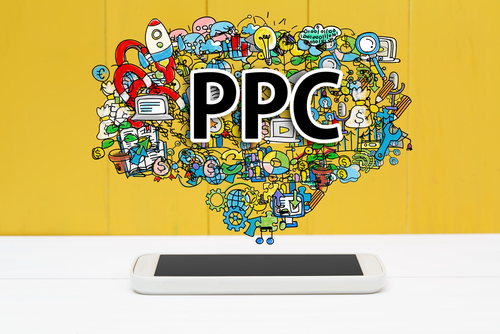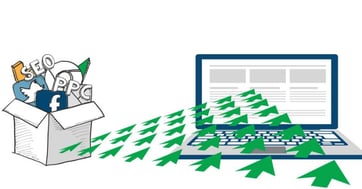Editor's Note: This post was originally published in March 2017 and has been updated with additional content in May 2023.
Are you a business owner challenged with finding enough qualified leads for your business? Don't worry, you are not alone! This is one of the top questions we get regularly. It's the classic catch-22; you have a million things to do to support your business, and it would be great to solve the ongoing issue of finding enough people who want to buy your product or service regularly. This blog article will explain the various paid search advertising tactics that a company can use to generate leads quicker for their business.
1. Good Paid Search Starts with Great Keyword Research
While there are multiple ways a company can generate leads for their business online, pay-per-click remains one of the simplest and quickest ways to generate leads in almost any industry.
A basic pay-per-click (PPC) campaign will usually roll out as a highly targeted campaign by targeting the demographics of the clients you would like to attract. You will start with excellent keyword research to see how people are actually searching for your product or service online - no guessing here. If you have been running ads for some time, then conducting a periodic audit of search terms is essential since how your potential clients are looking for your products and services can change over time. While some companies choose to run these campaigns on their own, a professional firm that has run thousands of campaigns and has specialized knowledge in your industry can help significantly in identifying opportunities you might not otherwise be aware of. This helps ensure your precious ad dollars are not wasted, and the ads are properly optimized over time so you get the best results for your marketing spend.
2. Serve Up Relevant Offers at the Right Time with PPC
Usually, your initial PPC ads are in the form of a text ad since they are the most straightforward ads to generate (especially if you are doing it on your own). From here, multiple ads can be created to compare which ads are providing you with the best results. PPC ads are most effective when the ad served up is most relevant to what the buyer is searching for in a search engine. Because PPC allows you to reach the buyer right at the moment they are searching for their item, you have a golden opportunity to provide the buyer exactly what they need when they need it (i.e. it is 6 PM, and I am hungry and want to order a pizza, what deals are out there?) In this example, a pizza parlor looking to bring in more foot traffic or increase their online orders would use the hook of a coupon or promotional code in their PPC ad that is not only relevant and served up in their local area but is also timed to show up at the dinner hour. Implementing an ad campaign that is set up to reach a buyer where they are in their 'buying cycle' increases the likelihood of you selling something to that individual.
When there is a high search volume around a product or service, PPC is ideal for starting with lead generation. Not only do you want to ensure your business gets a piece of that high traffic volume, PPC has the targeting capabilities to manage your budget accordingly so you can manage your spending but still use it as a more immediate form of lead generation. This is especially important if your digital marketing strategy includes longer-term tactics such as search engine optimization, which can take months to start producing results.
3. Expand Your Brand Reach with Display Advertising
Display ads are online advertisements placed on websites that are highly relevant to what you are selling. They may be text, interactive, video, or image ads shown to people who are most likely to be interested in your product or service. The type of ad format you leverage will depend on the objectives of your ad campaign. An image-based ad is excellent for expanding your brand awareness and may include your company's logo or a picture of the specific product you provide. In contrast, a video ad is highly effective when you need help explaining a more complex product or service. These types of ads are effective when the search volume for a specific keyword may not be so high, but you have an idea of what kinds of websites or places your target audience hangs out online. Display ads are essential for established brands that need to keep the brand at the forefront. You can get millions of impressions over a short period of time and funnel traffic to your website or landing pages where customers can find out more detailed information about your services or immediately get in contact with you.
4. Bring Potential Customers Back to Your Site with Remarketing
Going hand in hand with display ads is a tactic known as remarketing or retargeting. We've all visited websites that we've browsed but didn't necessarily buy something on. But have you ever been on a website that you have visited that you then started to see ads for as you browsed other sites online? This is what we call remarketing. Using cookies, this highly effective method of exposure gets your ad out in front of your prospective customers time and time again, increasing the likelihood that they will remember they were on your website and prompt them to revisit and purchase from you. Even if they don't purchase immediately when they first visit your website, the psychology behind this persistent advertising is proven to have more than a 50% success rate of getting customers to purchase from you on a subsequent visit. Remarketing is a great way to grab the low-hanging digital fruit in your marketplace and is something every company online should have set up.
5. Use Social to Connect with Your Target Audience More Effectively
Social ads are becoming more and more common as people and companies flock to social media platforms at record speed. Entire communities for special interest groups have sprung up, making it ideal to find like-minded people like never before. For businesses, this represents an ideal opportunity to use the power of consumers for recommendations. Many consumers want a friend or family member to recommend a product or service before buying for themselves, and social networks have become the logical place for these discussions.
Likewise, being 'social' is all about getting unique insights into your target audience. For example, the Facebook platform has done an incredible job of defining who audiences are by having individuals share their demographic information online, making it the perfect place to advertise if you are a business-to-consumer brand. Through Facebook, you can even input your existing client emails and produce a 'look alike' audience - in other words, you can find more prospective clients that look similar to the clients you already have in your database. Because of the personal nature of these social sites, as a brand, you have an excellent opportunity to form relationships with your audience, brand yourself quickly, and develop exceptional customer loyalty, who, in return, create enthusiastic referrals.
Unlike traditional advertising, the best thing about paid search advertising, regardless of the tactic, is that you can easily measure your return on your marketing dollars! Lead generation has never had so many varied options, with such an ability to hyper-target your desired customers. With great research and knowledge of the type of client you would like to have, it is possible to get an online lead generation campaign up and running within a few days. For businesses that require an immediate source of leads, pay-per-click, display ads, and social ads are some of the quickest lead generation tactics for you to leverage online.
Developing a Robust Paid Search Strategy
A solid paid search strategy is crucial to not only driving traffic to your site but also converting that traffic into leads and customers. Here are some elements to consider when developing your strategy.
Understand Your Audience
Before you can create an effective paid search strategy, you need to understand who your audience is. What are their needs and wants? What problems are they trying to solve? By understanding your audience, you can create ads that speak directly to them, increasing the chances of a click-through.
Keyword Research
As highlighted earlier in this blog, keyword research is crucial to a successful paid search strategy. The keywords you choose to target will directly impact the traffic you draw to your site. Using tools like Google Keyword Planner can help you find relevant keywords that your audience is using in their search queries.
Creating Engaging Ad Copy
Once you have your keywords, it's time to create your ad copy. Your copy should be engaging and relevant to the keywords you're targeting. It should also include a strong call to action, guiding users on what they should do next.
Optimize Your Landing Pages
The journey doesn't end with a click on your ad. Once a user lands on your site, you need to ensure that they find what they're looking for. This means having landing pages that are relevant to your ad copy and keywords and that offer a seamless user experience.
Track and Refine
A successful paid search strategy involves constant tracking and refining. Monitor your campaigns closely to see what's working and what's not. Use the insights you gain to refine your strategy, making the necessary adjustments to improve performance.
Developing a strong paid search strategy can be a significant driver of leads for your business. However, it requires careful planning, execution, and monitoring. By paying attention to these key elements, you can create a strategy that drives results.
What is a Paid Search Strategy?
A paid search strategy, also known as pay-per-click (PPC) advertising, is a digital marketing approach where businesses pay to have their ads displayed on search engine results pages (SERPs) or other online platforms. With a paid search strategy, businesses bid on specific keywords relevant to their products or services, and their ads are displayed when users search for those keywords. The ads are typically labeled as "sponsored" or "ad" to differentiate them from organic search results. The cost of each click is determined through an auction-like system where the bid amount, ad relevance, and quality score are considered. Paid search allows businesses to target specific demographics, geographic locations, and search intent, ensuring their ads are shown to a highly relevant audience. It offers immediate visibility and potential traffic to a website, driving targeted leads and conversions. Effective paid search strategies involve careful keyword research, ad copy optimization, and ongoing monitoring and optimization to maximize the return on investment. By implementing a paid search strategy, businesses can increase their online visibility, drive targeted traffic to their website, and achieve their marketing goals more efficiently.
What is a Search Lead?
A search lead refers to a potential customer or prospect who has shown interest in a product or service by conducting a search query on a search engine. When a user enters a search term related to a particular product or service, they are actively seeking information or solutions. This presents an opportunity for businesses to capture and convert these search leads into customers. Search leads are valuable because they have expressed intent and are more likely to convert than leads generated through other means. By appearing prominently in search engine results pages (SERPs) through search engine optimization (SEO) or paid search advertising, businesses can attract search leads and direct them to their website or landing page. Once on the website, businesses can engage with search leads through compelling content, clear calls-to-action, and personalized messaging to nurture the lead and move them closer to purchasing or taking a desired action. Understanding user search intent, optimizing website content for pertinent keywords, and offering a seamless user experience are all necessary for efficiently capturing and converting search leads. By leveraging search leads, businesses can drive targeted traffic, increase conversions, and grow their customer base.
What Can Paid Search Do For You?
Even though Google does not publish its volume data, it is estimated that users make over 5.6 billion searches every single day! This is why more and more businesses are investing in paid searches to increase their chances of appearing in relevant search queries. So, how can paid search help your business:
- Accomplish your business goals to raise awareness or sell products and services by researching relevant keywords and bidding on them.
- Unlike SEO, paid search can help you develop your business strategy as you can receive and analyze results much quicker. It is also much easier to set up without the need for creatives or design.
- With paid search, you have the freedom to optimize each component, including copy, keywords, landing pages, ad extensions, and more. This flexibility allows you to determine what works and what does not for customers.
- Another great benefit you can enjoy with paid searches is that it is cost-effective, without the restriction of a minimum spending requirement. Similarly, you will be charged based on the clicks only, reducing the need to unnecessarily spend on user impressions, especially those who are not interested in engaging.
Avoid Pitfall #1: Not Tracking Return on Investment
Tracking your return on investment (ROI) for a marketing campaign is critical. It provides you with an understanding of which strategies work in relation to your audience, budget, and other factors. This process also helps in better budget management, aligning your strategies with the investment you make. Overall, tracking your return on investment can help with the following:
- Identify strategies that are the most effective for your business.
- Understand which strategies have the most significant impact on your customers and potential consumers.
- Make better investment decisions in your marketing budget.
- Achieve your business goals by tracking what works and what does not.
Avoid Pitfall #2: Running on All Broad Match Keywords
A default match type, broad match keywords, can be used to display your ads if a user searches for a keyword, its variations, and searches related to it. For example, if your broad match keyword is 'woman's hat,' your ad will also be shown to people searching for hats, women's accessories, or women's caps. However, it is not recommended to use only broad-match keywords.
The beauty of using paid searches and researched keywords is that you can specifically target your customer and meet their needs. However, if you only use broad-match keywords, you may be in danger of grouping multiple users - even those uninterested in your product or services.
Avoid Pitfall #3: Focusing on Activities, Not Outcomes
Your marketing campaign must focus on outcomes instead of the activities that get you there. Activities, also known as outputs, are the avenues and actions you take to reach customers. Outcomes, on the other hand, are the results of the said activities. Businesses measuring the time and effort put into activities only get half a picture, as this does not necessarily guarantee marketing effectiveness or progress.
However, measuring outcomes can determine how effective your activities are, which is a more tangible determinant of the success of your marketing campaign.
Avoid Pitfall #4: Not Calculating the Conversion Rate Required
Simply put, your conversion rate identifies how effective your marketing campaign is. It shows if you are 'converting' users, i.e., making them do what you want them to. The most common types of conversions are buying your product, filling out a form, contacting your business, signing up, subscribing, and many more.
Calculating the conversion rate helps you understand which components of your campaigns are successful in engaging customers. Conversely, if your conversion rate is low, you can make the appropriate changes so customers are more inclined to interact with your business.
Avoid Pitfall #5: Not Forecasting Your Likely Results Before You Begin
At WSI, we believe forecasting should be at the heart of every marketing campaign to anticipate the results and goals that the business will achieve. In a nutshell, the reasons why forecasting is critical for business success are as follows:
- You can make better business and marketing investments.
- You can predict demand and plan more efficiently throughout the year.
- You can identify problems and mitigate them with ease
A Glossary of Abbreviations
CPC
CPC, or Cost-Per-Click, is a metric that calculates the overall cost per click of an ad. For example, if you have paid $50 for an ad and receive 50 clicks, you can conclude that each click has cost you $1.
CPM
CPM stands for cost per thousand impressions and is used in marketing campaigns viewed by thousands of people. This traditional marketing metric and paid advertising option are when a business pays a cost every time their ad receives 1000 impressions or views.
PLA
PLA or Product Listing Ads have a product image and a link that leads to a landing page of the said product. This is most often seen on Google Search Engine Results Page (SERPs) when a user types in a keyword.
PPC
PPC or Pay Per Click involves an advertiser paying a publisher every time a user clicks on their ad. It is an excellent method to increase your top-of-funnel leads.
SEM
Search Engine Marketing, or SEM, utilizes paid advertising strategies to increase visibility on search engine results pages.
Google Ads
Developed by Google, Google Ads is a dynamic space for advertisers to create ads published on the platform they want with a budget they can afford. These ads aim to reach the maximum number of people interested in a particular business' products and services.
In Conclusion
What other lead generation tactics can you employ to grow your business? Book a discussion with a WSI Digital Marketing Consultant today.






